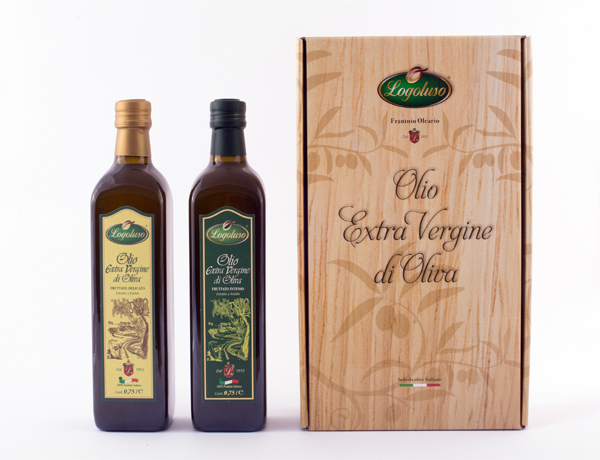What does the quality of an oil depend on?
It depends on series of factors that during all the route, from choice of olives to right grade of ripening, from type of extraction up to storage modalities of the obtained oil, contribute to determining the quality of the same.
In order to obtain a good oil it is essential to start from excellent raw material: the olive.
How is it possible to recognize a good Extra virgin Olive Oil?
A consumer who wants to verify by himself the features of an oil, needs to be careful to the fragrance: in this almost all most important information are concentrated . To identify them, pour a little quantity of oil in a little glass with the base larger than the hole (or in a spoon); warm it up for one minute with the hand and sniff it. The first smell of high quality oil is fruity: the same you can obtain crushing a fresh olive in your fingers. Then you will proceed to the actual tasting by putting a little oil between your teeth and lips and, with closed teeth aspiring firmly to vaporize seasoning in the mouth. In this way, besides the fruity, you will be able to smell many pleasant aromas, depending on the variety of olives and the type of processing.
The finest oils, produced with unriped and freshly picked olives, have a marked “intense” flavour; those born from more mature fruits a sweeter taste, called “delicate”. Defects may be due to a bad harvest, to errors of processing.
If the olives have been kept piled long before pressing, the taste will be “heated”, and if the oil has already begun to alter, that will be “rancid”.
A bad oil may even taste of “mould” or “metal” and the absence of flavours or aromas is already a serious defect.
Is a first-pressing oil better?
It is a statement that has no meaning because all the oils come from “first and only” pressing.
Which oil is the most suitable for frying? What is the point of smoke?
Thanks to the presence of more stable fatty acids than those found in seed oils, extra virgin olive oil is ideal for frying. In fact, the critical temperature of extra virgin olive oil (the point of smoke) is significantly higher than the usual temperature of frying food. The other fats such as butter, margarins and the most common seed oils, have a significantly lower critical temperature and during frying they lead to the formation of a croleum and other oxidation damaging substances harmful to health.
What is acidity? What does this mean?
It is the percentage of free fatty acids contained in the oil and indicates the greater or less degradation of the oils from which it is obtained, the less it is the more the olives were in good condition.
The oil capacity is not perceptible to taste but it can only be surpassed with a chemical analysis.
It is therefore not to be confused the tingling of fresh and healthy oils with the higher acidity.
What are polyphenols?
They are antioxidant substances that, like and even more than vitamin E, slow down the ossification or aging of the cells of our body. They have a slightly bitter and pungent taste that characterizes the high quality oils, they are distributed to a large extent in nature as well as in oil, fruit and especially in the grape skin where they are also responsible for its colouring.
What does the word “cultivar” means?
A word that defines the variety of an olive tree of the European Olea species.
How can you keep in better conditions extra virgin oil?
It should be protected from light, cool and above all “well capped”.
The product has a settling on the bottom. What does it depend on?
In some cases the oil bottled “unfiltered” , with thermal excursion during storage settles on the product but it is not affected by any problem.
What is the “panel test”?
It is the method of checking the quality of the oil based on the score expressed by a commission of tasters. With the tests of determination of personal sensitivity thresholds, 10 tasters trained to appreciate the characteristic taste of virgin oils are selected. According to a guide card, tasters, in a separate and autonomous way, ascertain the presence and the intensity of the basic system and in terms of these, identify a scaling of scores or set the most appropriate numerical evaluation with values from 1 to 9; the average of the data scores is then made from every tasters and , if the calculation of the value on the average admits its reliability, the average value constitutes the numerical evaluation of the organoleptic characteristics of the oil.
Has the oil an expiration date?
It’s necessary to consume the oil within 18 months from the bottling date indicated on the label.
In the following period it doesn’t become harmful but degrades from the organoleptic and nutritional point of view.
Does the colour of the oil indicate the greater or smaller genuineness of the same?
The intensity of the colour of the oil doesn’t indicate a greater genuineness as the density and the colour varies with the variation of the production area, the variety and the degree of ripening of the olives.
What is the difference between the extra virgin olive oil and seed oil?
Extra virgin olive oil is different from seed oil as well as for the extraction method, also for its nutritional, anti-oxidant and healthy properties as it comes directly from a fruit.


